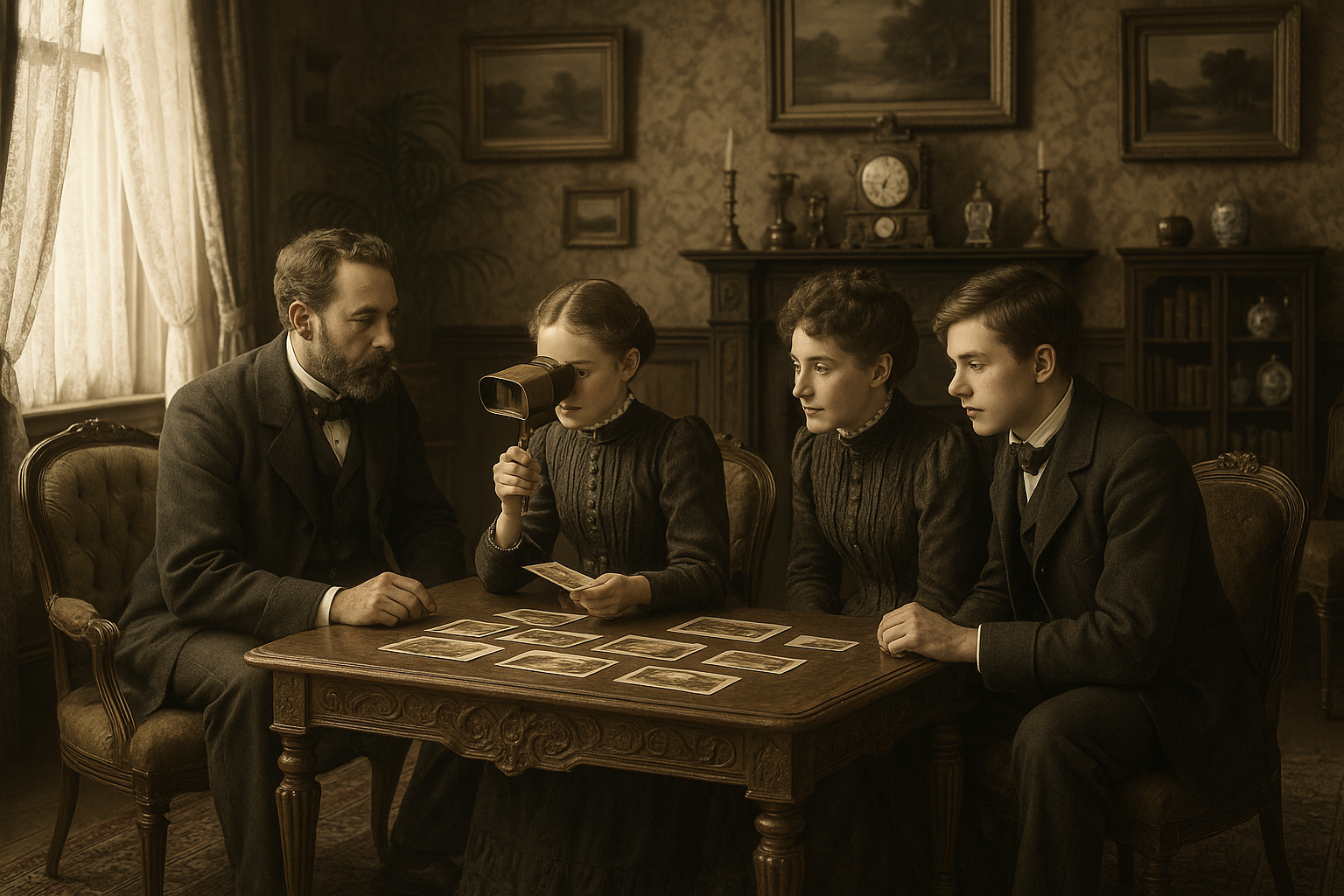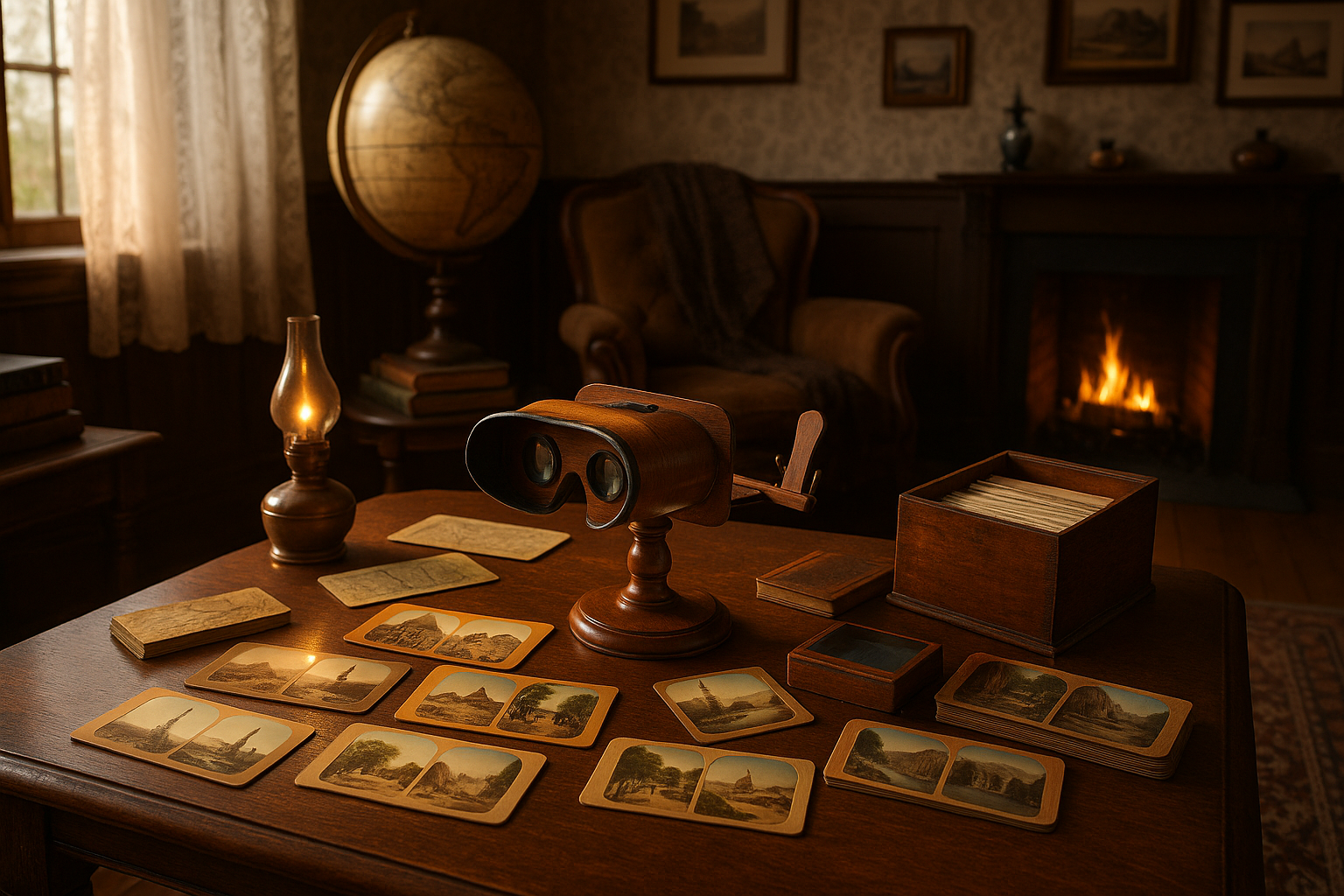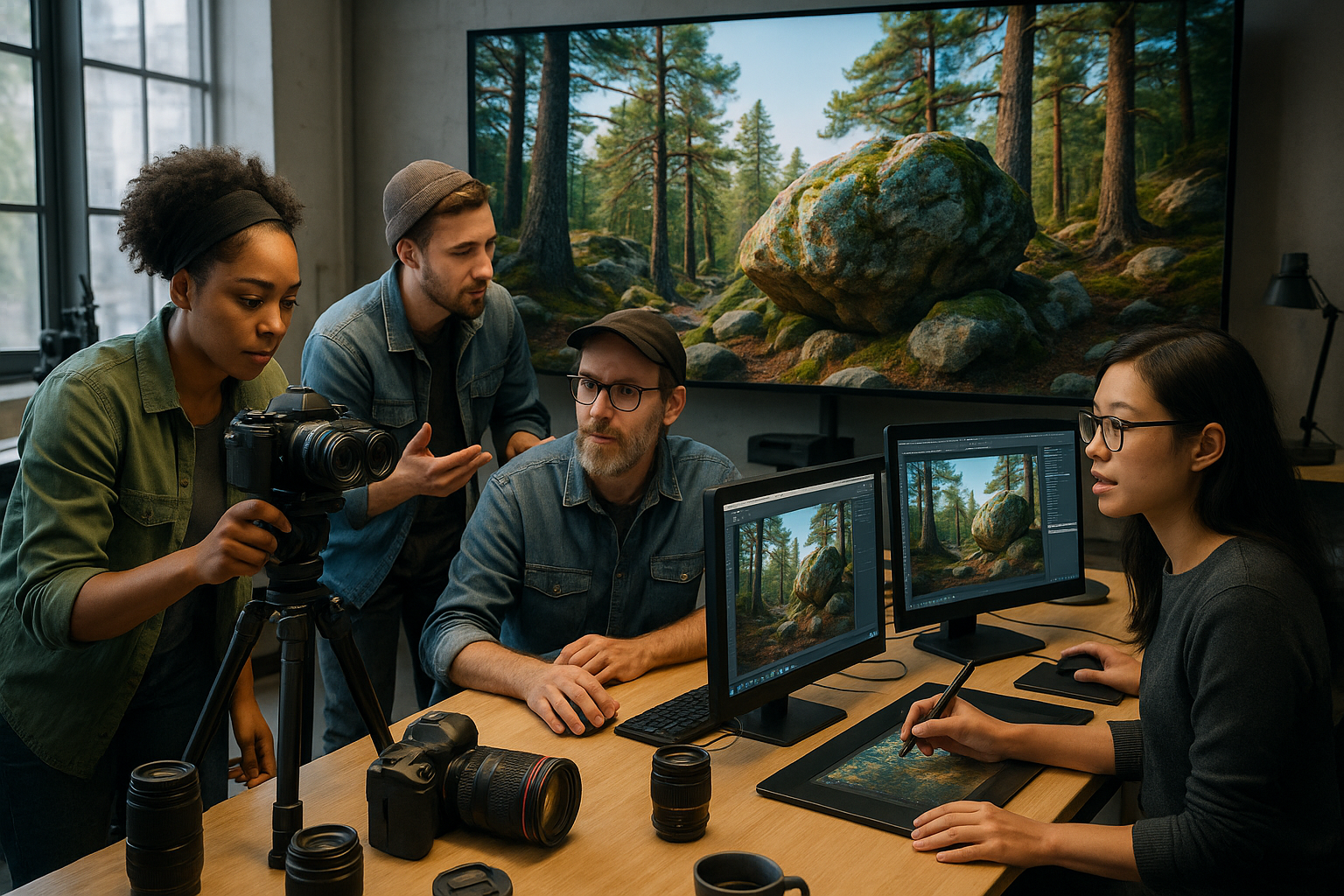Stepping back into the 19th century, one finds themselves enveloped in the opulence and charm of Victorian parlors—spaces that were not only the heart of the home but also a reflection of the technological and artistic innovations of the time. The Victorian era, spanning from 1837 to 1901, was a period of great transformation and creativity, marked by its unique blend of elegance and inventiveness. It was an age where tradition met modernity, and the parlor served as the perfect canvas for this cultural interplay. In this blog, we will journey through these opulent rooms, exploring the devices and decor that defined an era, leaving a lasting legacy that continues to captivate our imaginations today.
Imagine entering a Victorian parlor: the soft glow of gas lamps casting gentle light on richly patterned wallpaper and heavy draperies, the scent of burning coal mingling with the perfume of fresh flowers meticulously arranged in vases, and the faint hum of conversation or the sound of a piano filling the air. This was a space designed not only for comfort and aesthetic pleasure but also to showcase the technological advancements that were revolutionizing everyday life. The parlor was often adorned with the latest inventions, such as the phonograph and stereoscope, offering a glimpse into a world of innovation and progress. These devices were more than mere novelties; they were symbols of a society in transition, eager to embrace the future while honoring the past.
The Victorian parlor was a microcosm of the era’s fascination with art and beauty, where every piece of furniture and decor had its place and purpose. Ornate furniture, often crafted from dark woods and embellished with intricate carvings, was arranged with precision, reflecting the Victorian obsession with order and propriety. The walls were adorned with paintings and prints, each carefully selected to convey taste and status. Meanwhile, textiles played a crucial role in the parlor’s aesthetic, with rich fabrics such as velvet and brocade adding texture and depth to the environment. As we explore these decorative elements, we will also delve into the cultural and social significance they held, offering insights into the values and aspirations of the Victorian society.
Beyond aesthetics, the Victorian parlor was also a hub of social activity and intellectual exchange. It was a space where guests were entertained, ideas were debated, and cultural norms were both reinforced and challenged. This environment fostered a spirit of innovation, as inventors and artists found inspiration in the rapidly changing world around them. The parlor became a stage for showcasing inventions that would transform daily life, from the safety bicycle to the typewriter, each contributing to the democratization of leisure and communication. By examining these innovations, we gain a deeper understanding of how the Victorian era laid the groundwork for the technological advancements we enjoy today.
The Allure of Victorian Parlors
The Victorian era, spanning from 1837 to 1901, was a period of immense social, technological, and artistic change. At the heart of Victorian homes was the parlor, a room that embodied the elegance and complexity of the era. The parlor was a space for entertaining guests, showcasing one’s taste and status, and embracing the latest innovations in design and technology. This article delves into the unique features of Victorian parlors, exploring the distinctive devices and decor that defined this fascinating time.
Victorian parlors were characterized by their rich, opulent decor. Heavily influenced by Gothic, Rococo, and Neoclassical styles, these rooms were a tapestry of intricate patterns, luxurious materials, and ornate furnishings. Velvet, silk, and brocade were commonly used in upholstery, while dark woods such as mahogany and walnut lent a sense of warmth and grandeur. The walls often featured elaborate wallpaper, with florals, damasks, and trompe-l’œil designs being particularly popular. To add to the drama, parlors were filled with decorative objects like porcelain figurines, elaborate clocks, and glass domes housing taxidermied animals or dried flowers.
Beyond their aesthetic appeal, Victorian parlors were also showcases for the era’s technological advancements. The Industrial Revolution had introduced new manufacturing techniques, making it possible to produce more affordable and varied household items. This was reflected in the array of gadgets and devices that populated Victorian parlors. Innovations like the stereoscope, which allowed users to view 3D images, and the Edison phonograph, which brought recorded music into the home, were must-have items for the modern Victorian family. Such devices not only provided entertainment but also served as symbols of progress and sophistication.
Technological Innovations in Victorian Parlors
The Industrial Revolution brought about significant technological advancements that were eagerly embraced by the Victorians, transforming the parlor into a hub of innovation. Among the most notable inventions was the stereoscope, a device that created the illusion of three-dimensional images from two-dimensional pictures. It was a popular form of entertainment that captivated people with its ability to bring scenes from around the world into the home. This fascination with visual innovation extended to other areas, such as photography, which became increasingly accessible to the middle class.
Another groundbreaking invention of the era was the phonograph, patented by Thomas Edison in 1877. The phonograph was the first device capable of recording and reproducing sound, and it quickly became a centerpiece in Victorian parlors. Families could now enjoy music, poetry readings, and speeches without leaving their homes. The phonograph represented a shift in how people consumed media, paving the way for modern audio technologies. Watch the video below to learn more about how the phonograph changed the landscape of home entertainment: [Link to YouTube Video].
In addition to entertainment devices, Victorian parlors often housed various scientific instruments. Barometers, telescopes, and microscopes were not uncommon and were used to educate and fascinate guests. These instruments reflected the Victorian passion for exploration and discovery, as well as a growing interest in the natural world.
| Victorian Device | Description | Modern Equivalent |
|---|---|---|
| Stereoscope | Device for viewing 3D images | Virtual Reality Headset |
| Phonograph | Sound recording and reproduction | Record Player/MP3 Player |
| Barometer | Instrument for measuring atmospheric pressure | Digital Weather Station |
The Social Role of the Victorian Parlor
Victorian parlors were not just showcases for technological marvels and decorative arts; they also played a crucial role in the social life of the era. The parlor was the primary space for social interaction and entertainment. It was where families gathered to enjoy music, engage in lively discussions, and entertain guests. The etiquette of hosting was an important aspect of Victorian life, and the parlor was the stage upon which these social rituals were performed.
The art of conversation was highly valued, and the parlor provided a setting where people could engage in intellectual exchanges. Topics ranged from literature and art to politics and science, reflecting the diverse interests of the Victorian middle and upper classes. Parlor games, such as charades and card games, were popular pastimes that encouraged interaction and amusement.
Moreover, the parlor was often a space where women could express themselves and exert a degree of influence. While Victorian society was largely patriarchal, the parlor offered women an opportunity to manage the household’s social calendar and engage in meaningful conversation.
Decor and Aesthetic Values
The decor of Victorian parlors was a testament to the era’s complex aesthetic values, which emphasized abundance, ornamentation, and eclecticism. Victorian aesthetics celebrated the fusion of different styles and influences, resulting in a rich tapestry of design elements. This eclectic approach allowed homeowners to express their individuality and sophistication, making each parlor unique.
Wallpaper was a key component of Victorian decor, with intricate patterns and bold colors dominating the walls. Popular designs included floral motifs, geometric patterns, and scenic landscapes, often featuring vibrant hues like deep reds, greens, and golds. Carpets and rugs were equally lavish, typically made from luxurious materials like wool and featuring elaborate designs.
- Porcelain Figurines
- Bronze and Marble Statues
- Glass Domes with Taxidermy
- Elaborate Clocks
- Oil Paintings and Prints
The Evolution of Parlor Design
As the Victorian era progressed, parlor design evolved in response to changing tastes and technological advancements. The introduction of new materials and manufacturing techniques allowed for greater experimentation in design, leading to the development of new styles and trends. This evolution was also influenced by shifts in social norms and cultural values, as Victorians sought to balance tradition with modernity.
One significant trend in parlor design was the move towards lighter, more open spaces. While early Victorian parlors were characterized by dark colors and heavy furnishings, later designs embraced lighter hues and more delicate furniture. This shift was partly driven by the influence of the Arts and Crafts movement, which emphasized simplicity, craftsmanship, and natural materials.
Technological advancements also played a crucial role in the evolution of parlor design. The introduction of electric lighting, for example, transformed the way parlors were illuminated, allowing for greater flexibility and creativity in lighting design. Similarly, advances in heating technology made it possible to create more comfortable environments, free from the drafts and dampness that had characterized earlier homes.
Influence of Global Cultures
The Victorian era was a time of exploration and empire-building, and this global perspective was reflected in parlor design. As Victorians traveled the world, they brought back exotic artifacts and ideas that influenced the aesthetics of their homes. This fascination with the exotic is evident in the popularity of “Oriental” and “Moorish” styles, which incorporated elements from Asian, Middle Eastern, and African cultures.
Parlors often featured Japanese folding screens, Chinese vases, and Indian textiles, reflecting the Victorians’ fascination with distant lands. This eclectic mix of styles created a sense of adventure and curiosity, as homeowners sought to showcase their worldly knowledge and appreciation for diverse cultures. The incorporation of global influences not only enriched parlor design but also highlighted the interconnectedness of the Victorian world.
For a deeper understanding of the impact of global cultures on Victorian design, watch this insightful video: [YouTube Video Title, Channel Name]. This video explores how the exchange of ideas and artifacts between cultures shaped the aesthetics of the Victorian era, offering a fascinating glimpse into the global influences that defined this period of history.

Conclusion
Stepping back into the Victorian parlors offers a fascinating glimpse into an era defined by elegance, innovation, and an intricate balance of form and function. Throughout this exploration, we’ve delved into the multifaceted aspects that make Victorian parlors not only aesthetically captivating but also historically significant. From the intricate designs of the furniture to the groundbreaking technological innovations, each element played a pivotal role in shaping the social and cultural fabric of the time.
One of the key points discussed was the design and architecture of Victorian parlors. These spaces were meticulously crafted to reflect the social status and taste of the homeowners. The elaborate use of heavy draperies, ornate wallpapers, and opulent furnishings all contributed to creating an environment that was both inviting and imposing. The architecture itself, often featuring high ceilings and intricate woodwork, was a testament to the era’s penchant for detail and grandeur. This setting was not merely about aesthetics; it was a reflection of the Victorian values of propriety and respectability, where the parlor served as a stage for the social rituals of the time.
Technological innovation was another critical theme of our discussion. The Victorian era was a period of remarkable technological advancements, many of which found their way into the parlor. From the phonograph, which revolutionized the way people experienced music, to the gas lighting that transformed evening gatherings, these innovations were at the forefront of modernity. They symbolized progress and were often seen as status symbols that demonstrated the homeowners’ embrace of the future. The inclusion of such devices in the parlor highlighted the Victorians’ enthusiasm for technology and its potential to enhance daily life.
Moreover, the parlor was a center of social interaction and cultural expression. It was in these spaces that families gathered to read, play music, and entertain guests. Parlors were also the site of intellectual exchange, where ideas were shared, and cultural tastes were formed. This cultural vibrancy was further enhanced by the presence of art and literature, which were integral to the Victorian parlor experience. Paintings, sculptures, and books were not only decorative elements but also catalysts for conversation and reflection.
The Victorian parlor, therefore, was more than just a room; it was a microcosm of the era’s social, cultural, and technological currents. It embodied the aspirations and values of its time, serving as a bridge between tradition and innovation. By understanding these elements, we gain insight into how the Victorians navigated the complexities of their rapidly changing world.
The exploration of Victorian parlors is not just an exercise in nostalgia; it is an opportunity to appreciate the richness and diversity of a pivotal period in history. It reminds us of the enduring impact of design and technology on social life and cultural evolution. As we reflect on the elegance and innovation of Victorian parlors, we are inspired to consider how the spaces we inhabit today reflect our own values and aspirations.
We encourage you to share your thoughts and insights on this fascinating topic. How do you see the legacy of Victorian parlors influencing modern interior design? What parallels can you draw between the technological advancements of the Victorian era and those of today? Your perspectives are invaluable in enriching the conversation.
Feel free to share this article with friends and colleagues who might also appreciate a journey back in time. Exploring history through the lens of Victorian parlors offers a unique perspective on how past innovations continue to shape our present and future. Let us celebrate the elegance and ingenuity of this remarkable era and draw inspiration from its lessons as we create our own spaces of innovation and elegance today.
For further reading on the subject, you may explore resources such as the Victoria and Albert Museum’s online collections V&A Museum and the BBC’s history section on the Victorian era BBC History. These sites offer extensive information and visual documentation that deepen the understanding of this captivating period.
Toni Santos is a visual historian and artisan whose creative lens is captivated by the forgotten marvels of antique optical devices. Through his thoughtful storytelling, Toni revives the instruments that once transformed light into wonder—camera obscuras, magic lanterns, kaleidoscopes, and other ingenious tools that shaped our earliest visual imaginations.
His journey is rooted in a fascination with how humans have long sought to bend, reflect, and reveal the unseen. Whether tracing the mechanical poetry of 19th-century projectors or illustrating the tactile elegance of early lenses, Toni’s work invites us to see vision itself as an evolving art form.
Blending handcrafted design with historical inquiry, Toni brings to life the material soul of these devices—celebrating not just how they functioned, but what they meant. His creations and curated stories illuminate a world where science, illusion, and beauty were intricately linked through glass and brass.
As the curator of Vizovex, Toni shares detailed studies, reconstructed artifacts, and immersive content that help others rediscover the origins of visual technology and the magic of analog perception.
His work is a tribute to:
The craftsmanship behind early visual instruments
The wonder of seeing through the eyes of another century
The intersection of optics, art, and imagination
Whether you’re a collector, a designer, or someone drawn to the lost poetry of vision, Toni welcomes you into a world where light is a storyteller—one prism, one lens, one forgotten invention at a time.





